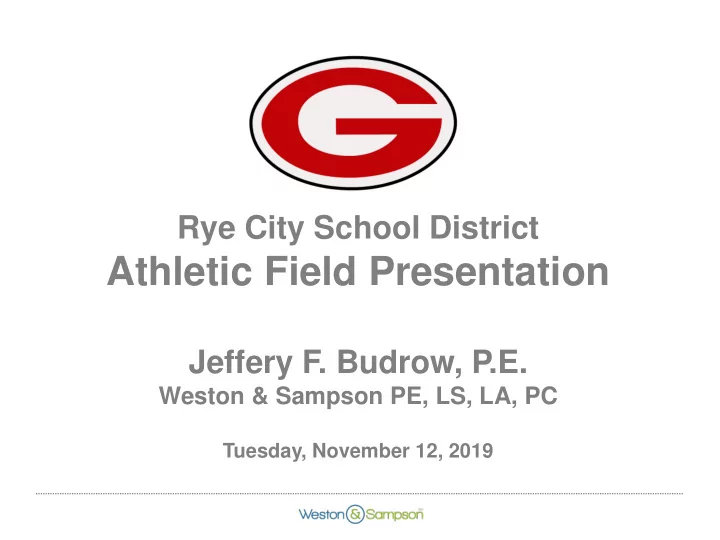

Rye City School District Athletic Field Presentation Jeffery F. Budrow, P.E. Weston & Sampson PE, LS, LA, PC Tuesday, November 12, 2019
Agenda Existing Field, Design Considerations • Limitations and Constraints • Turf Field Basics • Health & Environmental • Field Design •
Map
History • Constructed early 2000’s, again in 2004 • Reconstructed again in 2006 by FEMA • At the end of its useful life – 12 years avg. • Subject to periodic flooding – Floodplain vs. Floodway • Need for Replacement
Limitations/Constraints Limited Area • o Not enough space for fields – no equivalent space on site o Field used for multiple sports, Physical Education, Graduation o Constant usage, rain or shine, 1000 students, HS, MS, club, community, games, practice, recess, striped for 5 sports o Grass field cannot stand up to the usage Floodplain/Floodway • o Scour Velocity a design consideration o Infill materials are limited o Major regulatory and design hurdles to raising field Need for Replacement • o 13 years old, 12 is the average lifespan o Track, field, and tarping system included in bond referendum o A tarping system will improve its lifespan
Why Synthetic Turf? Sy Synthetic hetic Turf Sy Syst stem em Co Comp mpone nents nts
Synthetic Sy hetic Turf Fi Fiel eld d Infill ll Op Options ns Rubber | Plastic Natural | Organic Minerals/Coated Minerals Wide use, best performance + Organic Longest life before replacement resiliency Some recycled Prone to migrating, more Less resiliency, harder surface maintenance Perception of toxicity Requires shock pad*, higher Requires shock pad*, higher cost cost Heavy metals in trace amounts, Moisture required to retain Can be abrasive not releasable resiliency, can freeze Shock pad required with some May contain pesticides, heavy products metals in trace amounts that are releasable * Cannot be used due to environmental conditions
Sy Synthetic hetic Turf Fi Fiel eld d Infill ll Op Options ns Environmental Obstacles Recycled Virgin Pad Req’d Floats Floats Scours
Environmental • Floodplain Permit from City – No increase in elevation or fill in the project • Wetland Permit from NYSDEC – Buffer – No work in the wetlands • Stormwater and Erosion Control
Old Concerns • Crumb Rubber Issue – Trace Amounts of metals, perceived toxicity – Not releasable, “bound within the matrix” – Most levels below standards and background levels in soil – Meets CA Prop 65, European REACH, and ASTM F3188-16 (Toys) • Heat (due to black color) – Coating reduces this • Injury, Playability
Regulatory Input • NYSED • NYS DOH – 2009 Memo
New Concerns • PFAS/PFOA – Compounds are a concern in drinking water only – Are related to Teflon, used in manufacturing – Compounds were reported found in and around discarded turf – There is no science on this yet – Most manufacturers don’t use PFAS/PFOA in manufacturing – PFAS/PFOA don’t meet CA Proposition 65 Standard therefore cannot be present in fields we specify
Field Design New Field will support multiple sports. Striped for 5 sports. • Specified EPDM over crumb rubber (lower scour potential). SG • = 1.24 EPDM – crosslinked thermoset rubber – chemicals not • releasable Specified coated EPDM (Heat Reduction). • All materials to meet CA Proposition 65/ European Reach • Standards. Meets all constraints for playability, drainage, weather • We will secure CA Proposition 65 certifications from • manufacturers We are developing a lightweight, easily deployable tarping • system
Applicable Standards • California Proposition 65 • European Reach Standard • Reviewed and approved by NYSED • All necessary permits – City of Rye – NYSDEC
Thank You westonandsampson.com
Recommend
More recommend